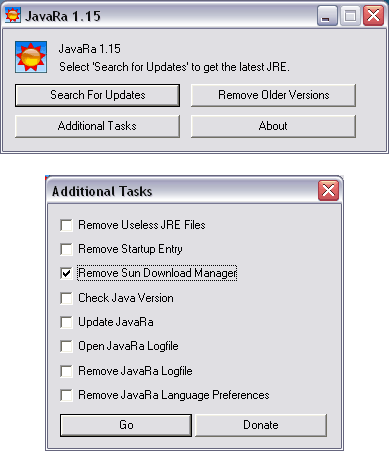Remove Old Java Versions Tool
Hi bruncar3, I would suggest you to run Windows Installer Cleanup Utility to remove Java completely from the computer. To uninstall Java, using Windows Installer Cleanup Utility. To uninstall Java, first remove the older versions like shown above and then go to Control Panel and Programs and Features. Click on the latest Java version listed there and click on Uninstall. Technically, this is all you should have to do, but if you really want to get rid of every trace of Java, I recommend using a freeware app called JavaRa. Once you download it, just run the application. This fixes the bug with Java versions 1.4.x removing a shared file all the 1.4.x uninstallers rely on. It leaves a few DLLs on the system but the security increase of removing all old Java versions outweighs that in our environment.

JavaRa is a free utility that will permanently remove all old and vulnerable versions of Java from your PC. Usage couldn't be simpler: just download it and run it. Sun Java has become a popular attack target for hackers and criminals as it can be found on almost every PC.
How do I uninstall Java on my Windows computer?
This article applies to:Uninstall Java Download
- Platform(s): Windows 10, Windows 2008 Server, Windows 7, Windows 8, Windows Server 2012, Windows Vista, Windows XP
» Learn more about the Java Uninstall tool
Remove Old Java Versions Tool
» Troubleshooting - Uninstaller toolManual Uninstall
You can uninstall older versions of Java manually in the same way as you would uninstall any other software from your Windows computer.
Older versions of Java may appear in the program list as J2SE, Java 2, Java SE or Java Runtime Environment.
Windows 10 - Uninstall Programs
- Click Start
- Select Settings
- Select System
- Select Apps & features
- Select the program to uninstall and then click its Uninstall button.
- Respond to the prompts to complete the uninstall
Windows 8 - Uninstall Programs
- From the Start screen, enter Control Panel in the Search box. Select the Control Panel.
- When the Control Panel appears, choose Uninstall a Program from the Programs category.
- Select the program to uninstall, and then right-click and select Uninstall or you can click the Uninstall option located at the top of the programs list.
- Click Yes to confirm the program uninstall.
Windows 7 and Vista - Uninstall Programs
- Click Start
- Select Control Panel
- Select Programs
- Click Programs and Features
- Select the program you want to uninstall by clicking on it, and then click the Uninstall button.
You may need administrator privileges to remove programs.
Windows XP - Uninstall Programs
- Click Start
- Select Control Panel
- Click the Add/Remove Programs control panel icon
- The Add/Remove control panel displays a list of software on your system, including any Java software products that are on your computer. Select any that you want to uninstall by clicking on it, and then click the Remove button.
Troubleshooting
If you run into issues removing Java, run the Microsoft utility to repair corrupted files and registry keys that prevents programs from being completely uninstalled or blocking new installations and updates. Intervideo windvd creator windows 10.
RELATED INFORMATIONWindows
- Windows 10 Uninstall Programs (Microsoft)
- Windows 8, Windows 7 Uninstall Programs (Microsoft)
Non-Windows
- Solaris Uninstall instructions (OTN)
You might also be interested in:
- How to find and uninstall stand-alone JavaFX from my system
hi i have to write a command line to uninstall java where it get current version already installed in system ?(suppose one system having jre-6u29 where other having jre-7).But i want single command line to uninstall existing version.please help me.
1 Answer
I have not tested this.
Use with EXTREME caution. It WILL NOT prompt for confirmation, and it WILL NOT let you cancel your action
Open a command prompt using administrator rights, and type in:

What this simple command is doing is:
- Find all the products installed on your computer which name starts with 'Java'
- Uninstalls them without asking for confirmation, nor showing any kind of user interface